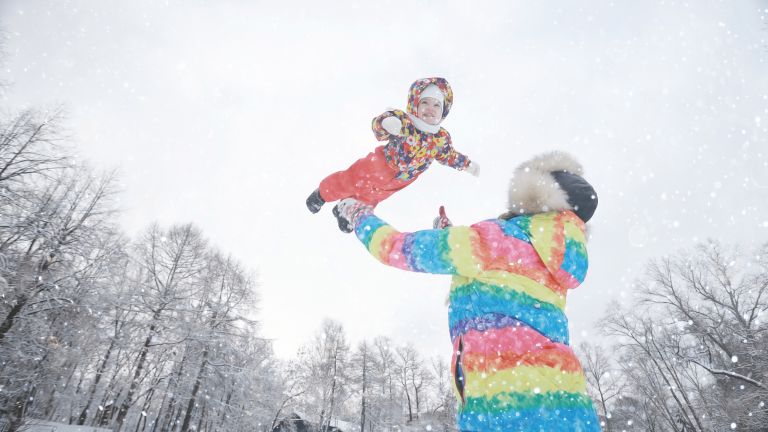
Baby Winter Guide: The first winter with a baby
- Created:
16. 11. 2021 - Updated:
27. 9. 2023

As far as the eye sees, the blankets of white snow and crystal icicles hanging from the roofs of houses can be seen. Fireplaces glowing red fire, blankets, and hot chocolate. Winter is here.
As beautiful as a walk through this winter wonderland, snow and freezing temperatures can be, it also causes problems for children. But don’t worry we prepared a winter guide for children, we will tell you how even the smallest ones can enjoy the first snowflakes in peace.
Snow, ice, and freezing temperatures: When the whole country wraps into the white blanket, it warms our hearts, but our fingers often freeze. So that even our little ones can enjoy the winter to the fullest, you should take them to the fresh air only with the right equipment. A walk through the winter wonderland has only positive qualities in it. For example, fresh air stimulates blood circulation and improves children’s sleep. In addition, the winter sun promotes the production of vitamin D.
💡 TIP: Top 10 Foods to Boost Kids Immunity
Are you wondering if your baby is already big enough for walk through the freezing winter? It depends on the temperature. At high temperatures below freezing, the baby should be older than three months. Avoid temperatures below -15 degrees Fahrenheit. If it is warmer, you can go for a winter walk two to three weeks after birth. In any case, the baby should not have any health problems. What else should you look out for during your first winter?

Five Tips on How to Handle Winter With a Baby
1. Thorough skincare
You don’t have to worry about delicate baby skin too much in winter than in spring or summer. The only difference is that you should now avoid using water-based creams, as they could freeze on the skin at sub-freezing temperatures. It is better to use creams against wind and winter weather, which will protect sensitive skin on the face and all around. If the skin is still irritated after a day out, panthenol creams can help.
2. Layers, layers and more layers
Pack your little darling so it’s not too hot or cold. Always put one extra layer on your baby than you have. In addition, when dressing your baby choose warm but breathable materials, such as wool. It is better to use several layers of clothing than one thick piece. The so-called onion layering heats up better because the air in the gaps insulates the heat.
‼️ Important: The child should never sweat at low temperatures. To check this, you can touch the baby’s neck with your hand, if it is pleasantly warm, everything is fine.
💡 TIP: The fur cover for the pram is especially important because the fur not only warms up but also has a regulating effect, which is useful, for example, when the sun comes out at noon and the baby is just sleeping outside.
3. Trust your feelings
Not sure if it’s not too snowy for a walk? Trust your feelings and stay at home with your baby. However, even at home, the child should not be too hot or cold. Even in this case, neck control helps.
4. Fresh air
As with adults, dry air from the heater can irritate the mucous membranes. Therefore, also ventilate the children’s room regularly. Wet wipes on heats can provide a better climate in the room. Humidity should ideally be between 50 and 70 percent. But definitely do not expose your little one to drafts.
5. Watch out for warning signs.
If your baby starts shivering, or his extremities – hands, feet, and face – are cold and red, or have turned pale and hard, bring baby inside right away. You shouldn’t rub the cold area to rewarm it, as this could further damage the cold skin. Instead, use warm washcloths to gently reheat the skin, then put on warm and dry clothes. If he doesn’t improve in a few minutes, call your doctor. Other signs that your infant has gotten too cold and needs medical attention are lethargy, non-responsiveness, and blue lips or face.
This Could Also Come in Handy
- Baby Fever – How to Handle It
- Top 10 Foods to Boost Kids Immunity
- 5 Ideas for Baby Christmas🎄 Pictures
- Christmas🎄Gifts Ideas For Everyone








